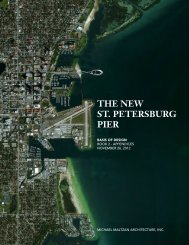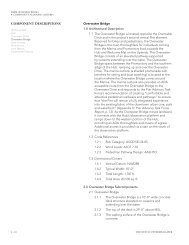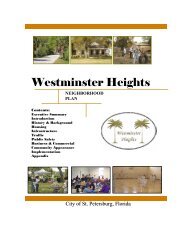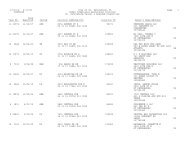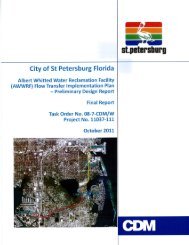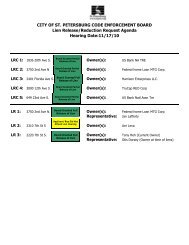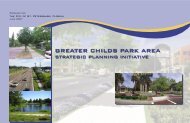Book 1 - City of St. Petersburg
Book 1 - City of St. Petersburg
Book 1 - City of St. Petersburg
Create successful ePaper yourself
Turn your PDF publications into a flip-book with our unique Google optimized e-Paper software.
for the Pier (during special events such as New Years Eve or 4th<br />
<strong>of</strong> July) has been calculated in the region <strong>of</strong> 9,000 people. It is<br />
to be noted however, that while this maximum occupant load<br />
will be used for the Pier’s egress calculations, it is expected that<br />
‘normal-day’ occupancy would be significantly lower than this<br />
number.<br />
Performance Based Egress Design Approach<br />
While the Building Code places no limitation on distances<br />
<strong>of</strong> travel in open-air assembly structures, the <strong>St</strong>. <strong>Petersburg</strong><br />
Building & Fire Departments have requested that the egress<br />
time <strong>of</strong> the Pier be assessed in order to establish an overall<br />
‘safe’ evacuation time for the structure at times <strong>of</strong> maximum<br />
occupation. As part <strong>of</strong> this evacuation time calculation, a<br />
performance-based design approach will be adopted in order to<br />
assess the following:<br />
1. The DISTANCE required for an occupant to move away from<br />
a fire location such that the occupant is considered ‘safe’<br />
2. The TIME taken for occupants to move away from a fire<br />
incident to a ‘safe’ location<br />
3. The TIME taken to COMPLETELY evacuate the Pier<br />
This is seen as an appropriate approach on the basis that;<br />
• As an outdoor space, there will be no smoke<br />
accumulation on the Pier (smoke will dissipate into the<br />
atmosphere)<br />
• Occupants will have sufficient distance/space to relocate<br />
to an area <strong>of</strong> relative safety, remote from a fire incident,<br />
while still remaining on the Pier<br />
A fire analysis/radiation study will be performed to determine<br />
the effects on occupants from a single design fire scenario on<br />
the Pier. Occupant safety, and hence the determination <strong>of</strong> a ‘safe<br />
distance’, will be measured against the radiation (heat transfer)<br />
that the fire emits to a defined zone on the Pier. A maximum<br />
radiative heat flux and temperature, based on research, will be<br />
selected for the acceptance criteria. Due to smoke’s ability to<br />
dissipate into the atmosphere, visibility through smoke, and<br />
other effects related to smoke will not be accounted for as part<br />
<strong>of</strong> the pass/fail criteria.<br />
In addition to this radiation study, an egress analysis will be<br />
completed to evaluate the time taken for occupants to reach a<br />
safe distance from a fire incident as well as to evacuate the Pier<br />
in its entirety. The s<strong>of</strong>tware used for this study assigns a series<br />
<strong>of</strong> characteristics to the occupants based on available research<br />
and data. Among others, these characteristics include travel/<br />
movement speeds, available paths based on the Pier’s geometry,<br />
and the ability for people to utilize egress elements due to their<br />
widths.<br />
MICHAEL MALTZAN ARCHITECTURE, INC. 3 - 123




